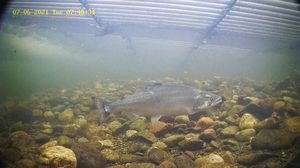Topic: Pink salmon in Norway

A pink salmon male, caught in Vestre Jakobselv, Finnmark, in 2021.
Photo: Christine Fagerbakke / IMR
Hunnfisk i gytedrakt fanget i organisert utfisking i Vestre Jakobselv i Finnmark i 2021.
Photo: Christine Fagerbakke / HavforskningsinstituttetI sjøfasen kan pukkellaksen minne om vår atlantiske laks eller sjørøye. Da er den en god matfisk beslektet med en annen populær stillehavslaks: regnbueørreten. På bilde er fangst fra et forskningstokt i Norskehavet.
Photo: Erling Kåre Stenevik / HavforskningsinstituttetPublished: 20.12.2022 Updated: 18.09.2023
This text has been translated using ChatGPT 3,5 and reviewed by the original human authors fluent in English, but not native speaking.
This text has yet to be updated with catch data from 2023.
Pink salmon, also known as humpback salmon (directly translated to “pukkellaks” in Norwegian), was introduced in several locations on the Kola Peninsula starting from the 1950s. This gave rise to a limited Russian fishery. However, the species had poor survival rates and didn't establish itself.
In the 1980s, Russians began introducing a more northern and hardy variant. This is the one that has now spread to Norwegian waters and rivers.
The fish has a strict two-year life cycle, leading to two separate populations: one that spawns in even-numbered years and one in odd-numbered years.
Every other year is a pink salmon year
The odd-year population is significantly larger than the even-year population. This could be due to genetic robustness and/or random favorable conditions in the sea.
This has led to an explosive increase in recent years, making odd years "pukkellaksår," at least since 2015.
Pink salmon are found in Norwegian rivers from south to north, with a significant presence in Troms and Finnmark.
Swim upriver, spawn and die
When they migrate to rivers for spawning, they quickly become unsuitable for consumption as their bodies change. The males then get the characteristic hump on the back.
A spotted tail and a black tongue are other telltale signs that make pink salmon distinguishable from our native Atlantic salmon.

After spawning, all pink salmon die in the river.
The fry hatch and migrate directly to the sea, where they grow for a year before returning to the rivers.
Biggest concern in the rivers
The main issue with pink salmon in Norway is that it can compete with native Atlantic salmon for spawning grounds in the rivers.
Additionally, when they die and decompose in large numbers, they add nutrients to the rivers, which can have unknown effects, including potential disease and contamination concerns.
New knowledge on diet and migration
Research from the Norwegian Institute of Marine Research (IMR) indicates that pink salmon utilize the entire Norwegian Sea as their feeding ground.
These findings primarily based on trawl catches during IMR's annual ecosystem survey in the Norwegian Sea.
Analysis of stomach contents shows that pink salmon eat similar prey to Atlantic salmon and mackerel, including amphipods, small fish, and krill.
Researchers are not concerned about competition for food in the rich sea, nor in the rivers, as pink salmon then cease feeding.
Pink salmon might have an effect in more local ecosystems at the coast or in the fjords, for example in competition with the sea troun (sea run brown trout). At least if the population will continue to increase.
Larger fish in the north than in the south
Pink salmon have been larger in Northern Norwegian rivers than in the south, likely due to better feeding conditions. For example, in 2021, the average size of pink salmon in Southern Norway was around 1 kilogram, increasing steadily to over 1.5 kilograms in Northern Norway.
There's no observed correlation between geography and the timing of river migration, meaning that the feeding season isn't necessarily longer in the North.
Pink salmon are caught incidentally in the limited salmon fishing at sea, using gillnets and trap nets. This fishing is restricted to specific periods and regions, mainly in Troms and Finnmark.
Targeted efforts to combat pink salmon have involved the use of nets, traps, harpoons, and angling in severely affected rivers. (Update 2023: This season, the Norwegian environmental authorities have tried using river barrier traps in severly affected rivers to control the pink salmon. More on this to come.)

In 2021, the most targeted removal of pukkelaks occurred in Vesterelva, with 20,153 fish removed. In the important Tanaelva river, no targeted measures were taken, but local fish counts estimated up to 50,000 pukkelaks in 2021. (To be updated with 2023 data.)
In comparison, the wild salmon population consists of around half a million fish that return to Norwegian rivers to spawn.
The Norwegian Environment Agency has established an expert group for pink salmon control, with representation from the Institute of Marine Research.